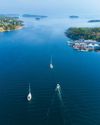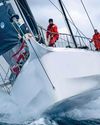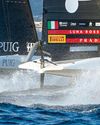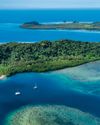
The Caspian Sea Monster was every bit as intimidating as its name suggests. At over 100ft long it flew at 230 knots just 20ft above the water's surface. With a lift capacity of 550 tonnes and 10 jet engines spread along its stubby wings and tail fin it was a beast of a machine.
Known officially as the Korabl Maket KM) it was the largest in a line of ground effect aircraft designed and built in the Soviet Union from the late 1950s through to the mid-1980s as part of the Ekranoplan project.
Despite having unusually short wings the KM could cover long distances at high speed as well as being able to carry much higher payloads more efficiently than a conventional aircraft of a similar size. In theory it was a winner, but in practice there were problems.
Maintaining stable flight close to the surface was said to be challenging for the pilots and when the sea state built it became difficult, if not impossible, to operate.
Manoeuvring was also an issue and required plenty of advanced warning to avoid obstacles. And then there was the issue of getting airborne in the first place. While the Sea Monster was efficient in flight it took a huge amount of power to get there. So, by the end of the 1980s as the Cold War started to thaw, the Ekranoplan project had pretty much fizzled out for the big beasts. But development in smaller ground effect vessels continued.
This story is from the February 2023 edition of Yachting World.
Start your 7-day Magzter GOLD free trial to access thousands of curated premium stories, and 9,000+ magazines and newspapers.
Already a subscriber ? Sign In
This story is from the February 2023 edition of Yachting World.
Start your 7-day Magzter GOLD free trial to access thousands of curated premium stories, and 9,000+ magazines and newspapers.
Already a subscriber? Sign In

5 EXPERT TIPS BOB BEGGS ON SAILING IN COLD WEATHER
As temperatures drop, Andy Rice gets tips on how to handle the cold from self-confessed Arctic weather fan and winning Clipper Round the World Race skipper Bob Beggs

SPECIAL REPORT EXTENDED CRUISING IN THE BALTIC
Sweden offers cruisers a warm welcome for winter - Janneke Kuysters has advice on how to boost your sailing time in the region

NIKKI HENDERSON
SEARCHING FOR MORE SPEED? BEFORE TINKERING WITH TINY ADJUSTMENTS, MAKE SURE YOU'VE GOT THE BASICS RIGHT THE POWER DRIVING THE BOAT

MATTHEW SHEAHAN
WHAT WILL THE BOATS OF THE 38TH AMERICA'S CUP LOOK LIKE? THAT'S THE $20 MILLION QUESTION IF BRITAIN OR NEW ZEALAND DECIDE TO DEPART FROM THE AC75

60-knot squalls hit Middle Sea Race
The 45th running of the Mediterranean offshore, the Rolex Middle Sea Race, saw a spectacularly random mix of conditions - even for a race which is famed for its variable weather patterns.

Italy win first Women's Cup
The first ever Women's America's Cup was won by Luna Rossa Prada Pirelli after a single, twoboat shoot-out final on 12 October.

'Three-peat' for ETNZ
As Defender, Emirates Team New Zealand came into this year's 37th America's Cup as clear favourites. But the Kiwi camp has far more than just the structural advantage of being the ones that wrote the Protocol for the competition, and the originators of the AC75 concept.

ROOM WITH A VIEW
SWEDISH DESIGNER GABRIEL HEYMAN POURED A LIFETIME OF IDEAS INTO THIS PILOT SALOON CRUISER, WHICH INCLUDES ARGUABLY THE LARGEST COCKPIT AVAILABLE AT THIS SIZE

LIVING HISTORY
THE ICONIC SEASON-CLOSING REGATTA LES VOILES DE SAINT TROPEZ WAS AN IMMERSIVE HISTORY LESSON FOR CROSBIE LORIMER

CHANGE OF PLAN
LEAVING AUSTRALIA, MARIANNE URTH NEVER PLANNED TO MAKE LANDFALL IN THE ISLANDS OF VANUATU, BUT THE EXPERIENCE WAS MAGICAL